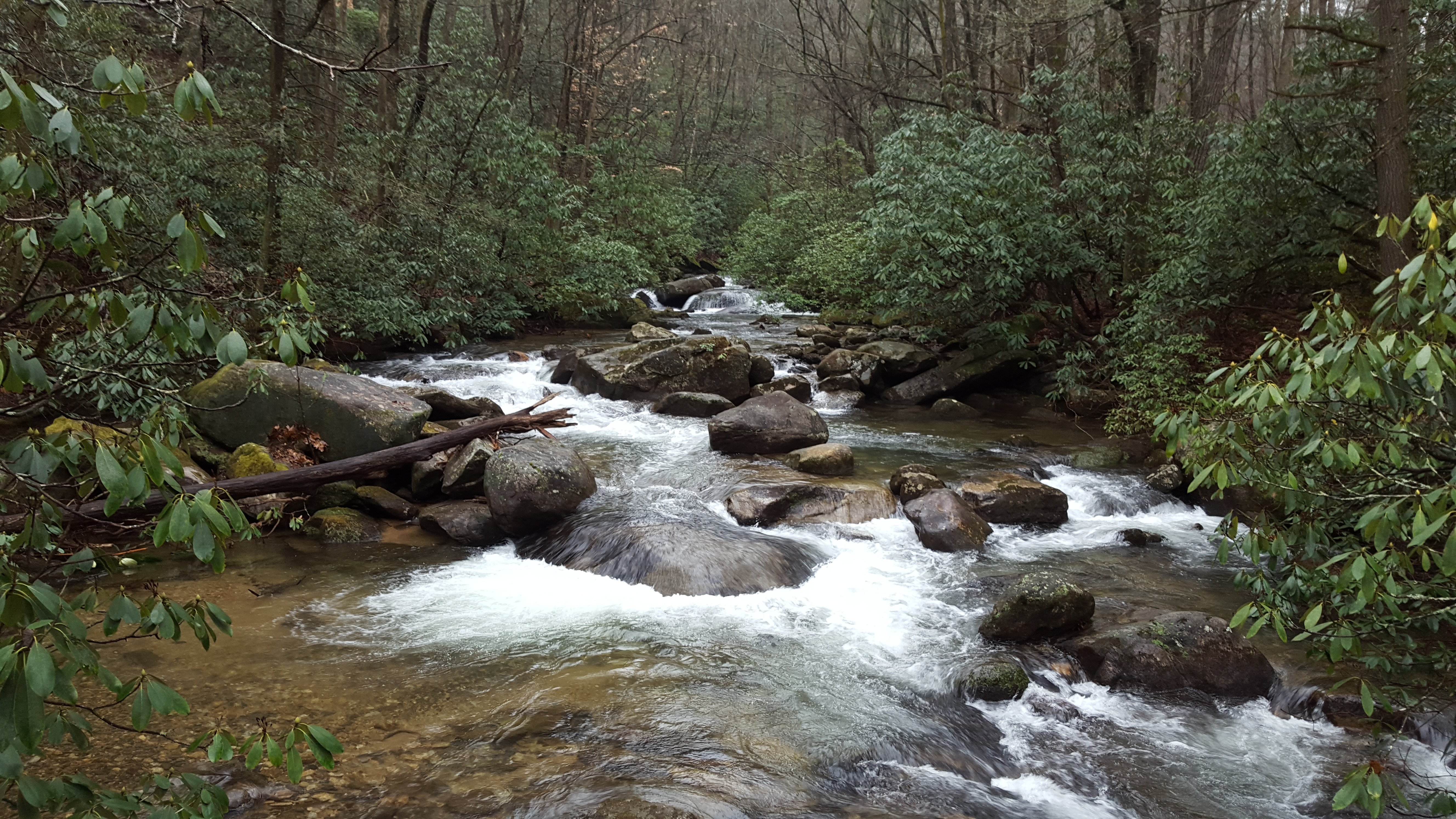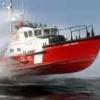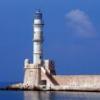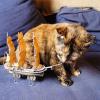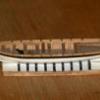Supplies of the Ship Modeler's Handbook are running out. Get your copy NOW before they are gone! Click on photo to order.
×
-
Posts
10,056 -
Joined
-
Last visited
Reputation Activity
-
 ccoyle reacted to gsdpic in Friendship Sloop by gsdpic - BlueJacket Shipcrafters - 1:12
ccoyle reacted to gsdpic in Friendship Sloop by gsdpic - BlueJacket Shipcrafters - 1:12
Well, before planking I need to work on the transom. The kit supplies a 3/16th laser cut piece of basswood for the transom, plus a laser cut 1/16th piece of mahogany. The instructions also say that the transom could just be planked and in fact that is what they show. Finally, the plan sheet also shows that the transom could be rounded some after planking. However that seems dubious if you use the 1/16th piece of mahogany. I also noticed that the laser cut deck was a bit long and would hang over the transom a bit.
I threw all that info into the mental blender and came up with a plan. First, I added some vertical pieces of scrap wood to the base transom piece. I also started fairing the large base piece.
I scraped, planed, and sanded those down so that I could apply the mahogany piece and end up with a rounded transom.
I think it will fit better but I have a lot of work to do to get it the correct shape with the correct fairing for the planking.
-
 ccoyle got a reaction from petervisser in Identifying a couple of models.
ccoyle got a reaction from petervisser in Identifying a couple of models.
The name "Blanco de Sal" is odd, since it literally means "white of salt." I think whoever manufactured that curio meant to say "Barco de Sal," which means "ship of salt."
-
 ccoyle reacted to Jeff preisler in Spray by Jeff Preisler - BlueJacket Shipcrafters - 3/8" = 1'
ccoyle reacted to Jeff preisler in Spray by Jeff Preisler - BlueJacket Shipcrafters - 3/8" = 1'
After priming the hull with Dupli-Color scratch filler primer and final sanding, I marked out the waterline. Using Liquitex acrylic white mixed with some matt medium I brush painted the hull above the waterline, then below the waterline I brush painted with Tamiya dark copper. I wanted to give the paint the look of being faded and weather battered from the long voyage at sea. I first roughed up areas of the hull with some sanding sticks to give the appearance of worn faded paint then using my x-acto knife, I scraped in some various scratches. For the lower hull applied a wash of weathered copper and Caribbean mist, (product I found at hobby lobby). Lastly, for the upper hull I applied a sand color clay-based wash from Florymodels.co.uk: what is nice about this clay wash from Flory is that even after it dries you can rub it off if it's not to your liking.
-
 ccoyle got a reaction from KARAVOKIRIS in PHOENIX 1787 by ccoyle - Master Korabel - 1/72 - Russian brigantine of the Black Sea Fleet
ccoyle got a reaction from KARAVOKIRIS in PHOENIX 1787 by ccoyle - Master Korabel - 1/72 - Russian brigantine of the Black Sea Fleet
All the inboard bulwark veneers have been added, along with the covering boards.
After fixing some of the chipped second planking layer, here's where we now stand compared to where we left off last May:
That's all for now!
-
 ccoyle reacted to Coyote_6 in Prince de Neufchatel by Coyote_6 – Constructo – 1/58 scale - American privateer
ccoyle reacted to Coyote_6 in Prince de Neufchatel by Coyote_6 – Constructo – 1/58 scale - American privateer
Tiller damper rigging completed.
-
 ccoyle reacted to yvesvidal in Le Chebec by Yvesvidal - CAF Model - 1/48
ccoyle reacted to yvesvidal in Le Chebec by Yvesvidal - CAF Model - 1/48
Next step is to install the bulwarks supports on top of the deck. According to the documentation, here is what must be done:
I thought I could use the slots in the cradle to guide me....Besides the first three or four supports that are working well, the cradle horizontal plates are conflicting with the supports. It is then mandatory to now extract the hull from its cradle. Rather delicate operation...
Last picture in the cradle (at least for a while or most likely for ever....):
Rolling drums......!!!!!!!!!!!!!!!
It came out nicely, without too many unpleasant noises and bad surprises. Nothing was broken and no parts were found at the bottom of the cradle:
Big relief overall.
That cradle was great and turned out to be very well designed and sturdy. The hull assembly is so light, it is incredible. What a contrast with the Bellona hull which was weighing 10 pounds with nothing built inside. The Chebec is clearly showing how light and sturdy it was designed and how quick it must have been on the Mediterranean sea.
The weight is unbelievable. It is like holding these ultra-lights that people operate in large warehouses:
It is still a big hull and will make a nice model:
Yves
-
 ccoyle got a reaction from Cathead in PHOENIX 1787 by ccoyle - Master Korabel - 1/72 - Russian brigantine of the Black Sea Fleet
ccoyle got a reaction from Cathead in PHOENIX 1787 by ccoyle - Master Korabel - 1/72 - Russian brigantine of the Black Sea Fleet
All the inboard bulwark veneers have been added, along with the covering boards.
After fixing some of the chipped second planking layer, here's where we now stand compared to where we left off last May:
That's all for now!
-
 ccoyle got a reaction from Cathead in PHOENIX 1787 by ccoyle - Master Korabel - 1/72 - Russian brigantine of the Black Sea Fleet
ccoyle got a reaction from Cathead in PHOENIX 1787 by ccoyle - Master Korabel - 1/72 - Russian brigantine of the Black Sea Fleet
Once the decks are on it's time to start working on the inboard veneers. These are not as easy to work with as the concept might sound. The veneers are beautiful, but also thin and therefore brittle and prone to warping when wet, as when coated with wood glue. I learned this last bit through trial and error -- mainly error. I got the port veneer on in one piece, luckily. The starboard side had some fit issues -- only the first gun port cutout aligned properly; the others were off by about 0.5mm. So I did this:
I then glued in the forward piece and trimmed the second piece so it would align properly.
And then things went south.
The aft piece of veneer resisted not one but TWO attempts to glue in and seat properly thanks to the veneer's aggravating tendency to curl when wet. There's a narrow channel between the deck and bulwark that the veneer is supposed to be seated in, and curling didn't help. Each time I pulled the veneer off I had to scrape the cured glue out of the channel with a dental pick. Then I did this:
This allowed me to install the piece in smaller chunks. Things worked out this time.
The process is going rather slowly because I am first wetting, shaping, drying, and varnishing the veneers before installing them, so there's a lot of drying time added to the schedule.
That's it for now! Next up will be the quarterdeck veneers, followed by the covering boards.
-
 ccoyle reacted to JimO in Golden Hind by JimO - FINISHED - 1/35 scale - based on Airfix 1/72 scale with modifications
ccoyle reacted to JimO in Golden Hind by JimO - FINISHED - 1/35 scale - based on Airfix 1/72 scale with modifications
Guns and port hole covers on, working om decks and a wee bit of rigging.
-
 ccoyle reacted to hamilton in HMS Echo by Hamilton - Admiralty Models - 1:48 - cross-section
ccoyle reacted to hamilton in HMS Echo by Hamilton - Admiralty Models - 1:48 - cross-section
A bit more work at the bench this weekend - I decided to make the lower deck hatch. Here the practicum is a bit at odds with the model. The practicum speaks of a partial "aft hatch" behind this one, but this can't be, since the mast partners are immediately behind this hatch. There is also a lack of information in the practicum on the exact locations of the sheet and jeer bitts, so I'm a little confused as to where these should be - there is some info on this in the photos provided with the practicum, but it isn't really adequate to locating them....In any event, I did also go so far as to mill 11" and 10" square strips for the pump shafts (6) and the bitts (4) to use as blanks for working out the mast partners - though the upper deck framing will need at least to be partially complete before finalising these.
The hatch came together pretty easily. I took a card template of its basic dimensions and laid this out on a sheet of scrap ply. I then arranged some battens around it to lock in the head ledges and coamings in the proper place. The head ledges and coamings fit together with lap joints which are pretty straightforward.
The gratings were made from material scavenged from my never-to-be-finished Syren kit - these gratings are of roughly the correct size and were of sufficient quality (unlike those often supplied by other kit mnanufacturers) for these purposes. Because the gratings when assembled did not fit exactly right, I needed to add a couple of battens along the head ledges (image with clamps below) so that the gratings looked correct.
Overall this went very smoothly. And it's nice to start creating more of the superstructural features of the model, which immediate (I think) make it more satisfying to the eye even in its unfinished state.
Enjoy the photos and happy modelling
hamilton
-
 ccoyle got a reaction from thibaultron in Kawanishi N1K2-J Shiden "George" by Javlin - FINISHED - Hasegawa - 1/32 - PLASTIC
ccoyle got a reaction from thibaultron in Kawanishi N1K2-J Shiden "George" by Javlin - FINISHED - Hasegawa - 1/32 - PLASTIC
Not being an expert on WW2 Japanese paint flaking myself, I must place my trust in the researching skills and technical abilities of the kit's graphic artist. Regardless of whether the print accurately reflects the wear and tear of the original, it will look cool when built! 😉
-
 ccoyle got a reaction from Rik Thistle in REVIEW: Dutch 17th Century Ship Models in Paper by Ab Hoving
ccoyle got a reaction from Rik Thistle in REVIEW: Dutch 17th Century Ship Models in Paper by Ab Hoving
Dutch 17th Century Ship Models in Paper
An Introduction to Scratch Building Paper Ship Models
by Ab Hoving and Emiel Hoving
2024 Seawatch Books
USD $75.00
All photos courtesy of Seawatch Books
Long-time members of MSW will need little introduction to Ab Hoving, a man well known as a curator, modeler, and expert on 17th century Dutch shipbuilding. His exceptional knowledge in these areas is on display in his latest book, Dutch 17th Century Ship Models in Paper: An Introduction to Scratch Building Paper Ship Models. I really don't need to say much regarding the topic and intended purpose of the book, since both are plainly stated in the title and subtitle. Rather, I will focus on the Big Question that any potential buyer of the book will undoubtedly have in mind when thinking about putting the book in his or her shopping cart at Seawatch:
Can I actually build a card model of a 17th century Dutch ship using the methods outlined by Mr. Hoving in this book?
I believe the answer to that question is a solid yes. First of all, Ab's method will not be completely foreign to anyone who has built a wooden ship model from a kit -- it's a take on the classic plank-on-bulkhead technique, starting with a longitudinal hull profile and a set of bulkheads. Instead of wood, the hull is built up from card stock. After a first planking in card, the hull is then 'planked' with self-adhesive plastic film (this is the method that we have seen so expertly done by MSW members Doris and Firdajan).
Ab walks the builder through two models, a relatively simple smalschip ("narrow ship") and a more complex pinas. Templates for the framing and planking of both models are provided in the book, and digital copies are available at Seawatch's website for those who have purchased a copy. Of course, after the basic hull is constructed, it needs to be appropriately painted. One of the things I have always appreciated about Ab's models is the high degree of realism they project as a result of his particular painting and weathering techniques. These are outlined in the book as well.
The book has some interesting selling points in addition to being a how-to on card modeling. The first few chapters are devoted to the vagaries of modeling Dutch ships due to the paucity of original source material (and the reasons for why such is the case), how the author has coped with those limitations, and how his research and his model building are inextricably linked (we who enjoy Ab's models should therefore be thankful for his intense desire to understand a subject as admittedly esoteric as 17th century Dutch shipbuilding practice). The book is also richly illustrated, both with diagrams and with beautiful photographs of the author's models. I was quite surprised, in fact, to learn that the book's photos depicted Mr. Hoving's models and not original works by the Dutch masters! His photo compositions are that convincing. Readers will be pleased to learn that the book describes exactly how to create such compositions using Photoshop.
To summarize, purchasers of this book will receive some interesting insight into the author's research and background, detailed descriptions of how to build two different Dutch ships using a technique that can readily be used for other ship model subjects, a plethora of beautiful photographs suitable for any coffee table, and a treatise on how to create life-like photographic compositions incorporating one's own models. That makes it a worthwhile addition to most anyone's library.
-
 ccoyle got a reaction from Old Collingwood in Kawanishi N1K2-J Shiden "George" by Javlin - FINISHED - Hasegawa - 1/32 - PLASTIC
ccoyle got a reaction from Old Collingwood in Kawanishi N1K2-J Shiden "George" by Javlin - FINISHED - Hasegawa - 1/32 - PLASTIC
Not being an expert on WW2 Japanese paint flaking myself, I must place my trust in the researching skills and technical abilities of the kit's graphic artist. Regardless of whether the print accurately reflects the wear and tear of the original, it will look cool when built! 😉
-
 ccoyle got a reaction from king derelict in Kawanishi N1K2-J Shiden "George" by Javlin - FINISHED - Hasegawa - 1/32 - PLASTIC
ccoyle got a reaction from king derelict in Kawanishi N1K2-J Shiden "George" by Javlin - FINISHED - Hasegawa - 1/32 - PLASTIC
Not being an expert on WW2 Japanese paint flaking myself, I must place my trust in the researching skills and technical abilities of the kit's graphic artist. Regardless of whether the print accurately reflects the wear and tear of the original, it will look cool when built! 😉
-
 ccoyle got a reaction from Canute in Kawanishi N1K2-J Shiden "George" by Javlin - FINISHED - Hasegawa - 1/32 - PLASTIC
ccoyle got a reaction from Canute in Kawanishi N1K2-J Shiden "George" by Javlin - FINISHED - Hasegawa - 1/32 - PLASTIC
Not being an expert on WW2 Japanese paint flaking myself, I must place my trust in the researching skills and technical abilities of the kit's graphic artist. Regardless of whether the print accurately reflects the wear and tear of the original, it will look cool when built! 😉
-
 ccoyle got a reaction from Ryland Craze in PHOENIX 1787 by ccoyle - Master Korabel - 1/72 - Russian brigantine of the Black Sea Fleet
ccoyle got a reaction from Ryland Craze in PHOENIX 1787 by ccoyle - Master Korabel - 1/72 - Russian brigantine of the Black Sea Fleet
Once the decks are on it's time to start working on the inboard veneers. These are not as easy to work with as the concept might sound. The veneers are beautiful, but also thin and therefore brittle and prone to warping when wet, as when coated with wood glue. I learned this last bit through trial and error -- mainly error. I got the port veneer on in one piece, luckily. The starboard side had some fit issues -- only the first gun port cutout aligned properly; the others were off by about 0.5mm. So I did this:
I then glued in the forward piece and trimmed the second piece so it would align properly.
And then things went south.
The aft piece of veneer resisted not one but TWO attempts to glue in and seat properly thanks to the veneer's aggravating tendency to curl when wet. There's a narrow channel between the deck and bulwark that the veneer is supposed to be seated in, and curling didn't help. Each time I pulled the veneer off I had to scrape the cured glue out of the channel with a dental pick. Then I did this:
This allowed me to install the piece in smaller chunks. Things worked out this time.
The process is going rather slowly because I am first wetting, shaping, drying, and varnishing the veneers before installing them, so there's a lot of drying time added to the schedule.
That's it for now! Next up will be the quarterdeck veneers, followed by the covering boards.
-
 ccoyle got a reaction from Canute in PHOENIX 1787 by ccoyle - Master Korabel - 1/72 - Russian brigantine of the Black Sea Fleet
ccoyle got a reaction from Canute in PHOENIX 1787 by ccoyle - Master Korabel - 1/72 - Russian brigantine of the Black Sea Fleet
Once the decks are on it's time to start working on the inboard veneers. These are not as easy to work with as the concept might sound. The veneers are beautiful, but also thin and therefore brittle and prone to warping when wet, as when coated with wood glue. I learned this last bit through trial and error -- mainly error. I got the port veneer on in one piece, luckily. The starboard side had some fit issues -- only the first gun port cutout aligned properly; the others were off by about 0.5mm. So I did this:
I then glued in the forward piece and trimmed the second piece so it would align properly.
And then things went south.
The aft piece of veneer resisted not one but TWO attempts to glue in and seat properly thanks to the veneer's aggravating tendency to curl when wet. There's a narrow channel between the deck and bulwark that the veneer is supposed to be seated in, and curling didn't help. Each time I pulled the veneer off I had to scrape the cured glue out of the channel with a dental pick. Then I did this:
This allowed me to install the piece in smaller chunks. Things worked out this time.
The process is going rather slowly because I am first wetting, shaping, drying, and varnishing the veneers before installing them, so there's a lot of drying time added to the schedule.
That's it for now! Next up will be the quarterdeck veneers, followed by the covering boards.
-
 ccoyle got a reaction from ERS Rich in PHOENIX 1787 by ccoyle - Master Korabel - 1/72 - Russian brigantine of the Black Sea Fleet
ccoyle got a reaction from ERS Rich in PHOENIX 1787 by ccoyle - Master Korabel - 1/72 - Russian brigantine of the Black Sea Fleet
Time for the decks. The instructions recommend contact cement, which I opted not to use because contact cement allows absolutely zero working time -- make a mistake and it's permanent. I used wood glue and worked quickly. The edges wanted to curl up, but I held them down by clamping clothespins atop them along the bulwarks until dry.
Next I worked on the aft cabin bulkhead. It's two layers of veneer, with painted hinges and faux doorknobs made of cut-off brass nail daubed with white paint. Just dry fitted for now.
Cheers!
-
 ccoyle got a reaction from petervisser in PHOENIX 1787 by ccoyle - Master Korabel - 1/72 - Russian brigantine of the Black Sea Fleet
ccoyle got a reaction from petervisser in PHOENIX 1787 by ccoyle - Master Korabel - 1/72 - Russian brigantine of the Black Sea Fleet
Once the decks are on it's time to start working on the inboard veneers. These are not as easy to work with as the concept might sound. The veneers are beautiful, but also thin and therefore brittle and prone to warping when wet, as when coated with wood glue. I learned this last bit through trial and error -- mainly error. I got the port veneer on in one piece, luckily. The starboard side had some fit issues -- only the first gun port cutout aligned properly; the others were off by about 0.5mm. So I did this:
I then glued in the forward piece and trimmed the second piece so it would align properly.
And then things went south.
The aft piece of veneer resisted not one but TWO attempts to glue in and seat properly thanks to the veneer's aggravating tendency to curl when wet. There's a narrow channel between the deck and bulwark that the veneer is supposed to be seated in, and curling didn't help. Each time I pulled the veneer off I had to scrape the cured glue out of the channel with a dental pick. Then I did this:
This allowed me to install the piece in smaller chunks. Things worked out this time.
The process is going rather slowly because I am first wetting, shaping, drying, and varnishing the veneers before installing them, so there's a lot of drying time added to the schedule.
That's it for now! Next up will be the quarterdeck veneers, followed by the covering boards.
-
 ccoyle got a reaction from yvesvidal in PHOENIX 1787 by ccoyle - Master Korabel - 1/72 - Russian brigantine of the Black Sea Fleet
ccoyle got a reaction from yvesvidal in PHOENIX 1787 by ccoyle - Master Korabel - 1/72 - Russian brigantine of the Black Sea Fleet
Once the decks are on it's time to start working on the inboard veneers. These are not as easy to work with as the concept might sound. The veneers are beautiful, but also thin and therefore brittle and prone to warping when wet, as when coated with wood glue. I learned this last bit through trial and error -- mainly error. I got the port veneer on in one piece, luckily. The starboard side had some fit issues -- only the first gun port cutout aligned properly; the others were off by about 0.5mm. So I did this:
I then glued in the forward piece and trimmed the second piece so it would align properly.
And then things went south.
The aft piece of veneer resisted not one but TWO attempts to glue in and seat properly thanks to the veneer's aggravating tendency to curl when wet. There's a narrow channel between the deck and bulwark that the veneer is supposed to be seated in, and curling didn't help. Each time I pulled the veneer off I had to scrape the cured glue out of the channel with a dental pick. Then I did this:
This allowed me to install the piece in smaller chunks. Things worked out this time.
The process is going rather slowly because I am first wetting, shaping, drying, and varnishing the veneers before installing them, so there's a lot of drying time added to the schedule.
That's it for now! Next up will be the quarterdeck veneers, followed by the covering boards.
-
 ccoyle got a reaction from GrandpaPhil in PHOENIX 1787 by ccoyle - Master Korabel - 1/72 - Russian brigantine of the Black Sea Fleet
ccoyle got a reaction from GrandpaPhil in PHOENIX 1787 by ccoyle - Master Korabel - 1/72 - Russian brigantine of the Black Sea Fleet
Once the decks are on it's time to start working on the inboard veneers. These are not as easy to work with as the concept might sound. The veneers are beautiful, but also thin and therefore brittle and prone to warping when wet, as when coated with wood glue. I learned this last bit through trial and error -- mainly error. I got the port veneer on in one piece, luckily. The starboard side had some fit issues -- only the first gun port cutout aligned properly; the others were off by about 0.5mm. So I did this:
I then glued in the forward piece and trimmed the second piece so it would align properly.
And then things went south.
The aft piece of veneer resisted not one but TWO attempts to glue in and seat properly thanks to the veneer's aggravating tendency to curl when wet. There's a narrow channel between the deck and bulwark that the veneer is supposed to be seated in, and curling didn't help. Each time I pulled the veneer off I had to scrape the cured glue out of the channel with a dental pick. Then I did this:
This allowed me to install the piece in smaller chunks. Things worked out this time.
The process is going rather slowly because I am first wetting, shaping, drying, and varnishing the veneers before installing them, so there's a lot of drying time added to the schedule.
That's it for now! Next up will be the quarterdeck veneers, followed by the covering boards.
-
 ccoyle reacted to Keith Black in PHOENIX 1787 by ccoyle - Master Korabel - 1/72 - Russian brigantine of the Black Sea Fleet
ccoyle reacted to Keith Black in PHOENIX 1787 by ccoyle - Master Korabel - 1/72 - Russian brigantine of the Black Sea Fleet
Perseverance is the name of the game in so much of what we do. It turned out looking right spiffy, Chris.
-
 ccoyle got a reaction from KARAVOKIRIS in PHOENIX 1787 by ccoyle - Master Korabel - 1/72 - Russian brigantine of the Black Sea Fleet
ccoyle got a reaction from KARAVOKIRIS in PHOENIX 1787 by ccoyle - Master Korabel - 1/72 - Russian brigantine of the Black Sea Fleet
Once the decks are on it's time to start working on the inboard veneers. These are not as easy to work with as the concept might sound. The veneers are beautiful, but also thin and therefore brittle and prone to warping when wet, as when coated with wood glue. I learned this last bit through trial and error -- mainly error. I got the port veneer on in one piece, luckily. The starboard side had some fit issues -- only the first gun port cutout aligned properly; the others were off by about 0.5mm. So I did this:
I then glued in the forward piece and trimmed the second piece so it would align properly.
And then things went south.
The aft piece of veneer resisted not one but TWO attempts to glue in and seat properly thanks to the veneer's aggravating tendency to curl when wet. There's a narrow channel between the deck and bulwark that the veneer is supposed to be seated in, and curling didn't help. Each time I pulled the veneer off I had to scrape the cured glue out of the channel with a dental pick. Then I did this:
This allowed me to install the piece in smaller chunks. Things worked out this time.
The process is going rather slowly because I am first wetting, shaping, drying, and varnishing the veneers before installing them, so there's a lot of drying time added to the schedule.
That's it for now! Next up will be the quarterdeck veneers, followed by the covering boards.
-
 ccoyle got a reaction from mtbediz in PHOENIX 1787 by ccoyle - Master Korabel - 1/72 - Russian brigantine of the Black Sea Fleet
ccoyle got a reaction from mtbediz in PHOENIX 1787 by ccoyle - Master Korabel - 1/72 - Russian brigantine of the Black Sea Fleet
Once the decks are on it's time to start working on the inboard veneers. These are not as easy to work with as the concept might sound. The veneers are beautiful, but also thin and therefore brittle and prone to warping when wet, as when coated with wood glue. I learned this last bit through trial and error -- mainly error. I got the port veneer on in one piece, luckily. The starboard side had some fit issues -- only the first gun port cutout aligned properly; the others were off by about 0.5mm. So I did this:
I then glued in the forward piece and trimmed the second piece so it would align properly.
And then things went south.
The aft piece of veneer resisted not one but TWO attempts to glue in and seat properly thanks to the veneer's aggravating tendency to curl when wet. There's a narrow channel between the deck and bulwark that the veneer is supposed to be seated in, and curling didn't help. Each time I pulled the veneer off I had to scrape the cured glue out of the channel with a dental pick. Then I did this:
This allowed me to install the piece in smaller chunks. Things worked out this time.
The process is going rather slowly because I am first wetting, shaping, drying, and varnishing the veneers before installing them, so there's a lot of drying time added to the schedule.
That's it for now! Next up will be the quarterdeck veneers, followed by the covering boards.
-
 ccoyle got a reaction from Dave_E in PHOENIX 1787 by ccoyle - Master Korabel - 1/72 - Russian brigantine of the Black Sea Fleet
ccoyle got a reaction from Dave_E in PHOENIX 1787 by ccoyle - Master Korabel - 1/72 - Russian brigantine of the Black Sea Fleet
Once the decks are on it's time to start working on the inboard veneers. These are not as easy to work with as the concept might sound. The veneers are beautiful, but also thin and therefore brittle and prone to warping when wet, as when coated with wood glue. I learned this last bit through trial and error -- mainly error. I got the port veneer on in one piece, luckily. The starboard side had some fit issues -- only the first gun port cutout aligned properly; the others were off by about 0.5mm. So I did this:
I then glued in the forward piece and trimmed the second piece so it would align properly.
And then things went south.
The aft piece of veneer resisted not one but TWO attempts to glue in and seat properly thanks to the veneer's aggravating tendency to curl when wet. There's a narrow channel between the deck and bulwark that the veneer is supposed to be seated in, and curling didn't help. Each time I pulled the veneer off I had to scrape the cured glue out of the channel with a dental pick. Then I did this:
This allowed me to install the piece in smaller chunks. Things worked out this time.
The process is going rather slowly because I am first wetting, shaping, drying, and varnishing the veneers before installing them, so there's a lot of drying time added to the schedule.
That's it for now! Next up will be the quarterdeck veneers, followed by the covering boards.

